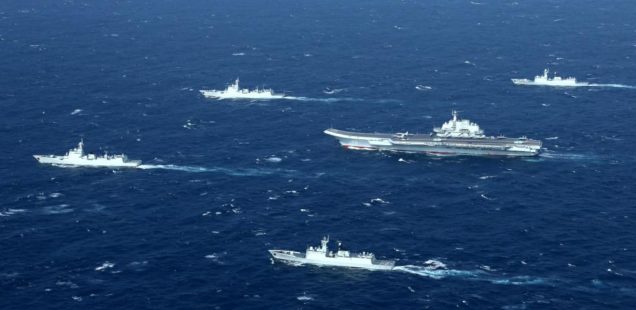
Trump Has No South China Sea Strategy—and Needs One Fast
The South China Sea question is rolling toward the Trump White House like a long, low Pacific wave. Whenever it breaks, the president’s going to need a strategy he doesn’t seem to have yet. The strategy is just a piece of what President Trump has to provide. Nearly as important is who in the administration takes the lead in shaping and executing US policy.
Trump could find a place in the White House attic for Barack Obama’s over-reaching “pivot to Asia” in favor of a wiser policy that acknowledges China’s emerging role in the region as inevitable. Defense Secretary Mattis could get the South China Sea file, and Secretary of State Tillerson, who has a thing or two to learn about power and diplomacy, does deputy’s duty.
Related: China Just Gave Trump a 999-Foot-Long Middle Finger
This looks possible at the moment. President Trump displays little interest in the strategic dimension of Asia policy, so he’s certain to put one or another cabinet member in charge of trans–Pacific security questions. Mattis is the performer thus far.
The South China Sea is a shallow but endlessly complicated body of water. Six nations—seven if you count Taiwan—now compete for maritime jurisdiction based on conflicting claims to sovereignty over 51 of roughly 150 islands, atolls, and specks of rock just above the waves south and east of the mainland’s coast.
The US, not to be missed, isn’t party to any of these disputes. Washington’s gripe is that China’s obvious rise as a regional power threatens American primacy in the western Pacific, which has gone unchallenged for 70–odd years. It’s early, but Trump and his people are so far leaving the policies they inherited in place. It amounts to flying on autopilot, and it won’t do.
Last weekend the Pentagon sent the Carl Vinson carrier group into the South China Sea amid reports it would conduct another of the Navy’s “freedom-of-navigation” cruises — deployments intended to observe international law but breach China’s maritime claims. There’s nothing new in this: Obama revived the moribund freedom-of-navigation tests in 2015. But it was pointlessly provocative then and even more so now. Nothing is accomplished and tensions worsen.
Related: The US Navy’s $13 Billion Answer to China and Russia
“China always respects the freedom of navigation and overflight that countries enjoy in the South China Sea under international law,” the Foreign Ministry in Beijing said Wednesday. “But we oppose relevant countries threatening and undermining the sovereignty and security of coastal states under the pretext of such freedom.”
Courteous, yes. But a warning, too. As elsewhere around the globe, this is testing time across the Pacific for the Trump administration. No one knows what it plans to do and everyone’s eager to find out.
A day before the Foreign Ministry statement on the Vinson, a Reuters exclusive quoted U.S. intelligence officials saying that China is completing nearly two dozen structures on disputed islands. Thirty-three feet high, twice as long, and with retractable roofs, these buildings are commonly used to house surface-to-air missiles.
Again, nothing new here. It’s hardly plausible that the structures China’s erecting on isolated atolls were begun since Trump took office. But if neither of these back-to-back developments is anything major, together they should be read as a harbinger. Some home truths about China and trans–Pacific policy ought to be landing in the White House right about now.
Related: China Is Ready to Step into America’s Role as World Leader
One, if the Pentagon isn’t going to react militarily to the new structures China is building to house SAMs, it’s unlikely to react to anything. Missions such as the Vinson’s amount to useless bluff.
The same goes for Rex Tillerson’s belligerent comment, “We’re going to have to send China a clear signal that, first, the island-building stops and, second, your access to those islands also is not going to be allowed,” Tillerson asserted.
Step back for another look. The US is a million miles from going to war over these specks in the sea, which doesn’t even straddle the shipping lanes Washington claims to be its main concern. Corollary point: China’s right to police and defend waters off its coast is no more negotiable than America’s. There’s no give here to exploit.
Two, it’s time to stop pretending the rest of Asia appreciates Washington’s confrontational approach. The US has a lot of frontage on the Pacific lake, and this is fine — even with the Chinese. Viewed from the Asian side of the ocean, however, Americans are up to only two things now: Making noise and making trouble.
Related: Trump’s Vow to Abandon the TPP Hands China a Huge Victory
The Filipinos just cut a deal with Beijing to reach a compromise on disputed territories. So has Vietnam, and Malaysia is in negotiations with the same intent. Thailand has no quarrel with China, but Bangkok is replacing outdated US military gear with Chinese-made fighter jets and a new submarine; new railroad stock is coming from China and Japan.
In short, the region is daily coming to terms with an economy that will soon equal America’s in size and which is already at the center of regional trade, investment, infrastructure financing, and tourism. How, you have to ask, does an aircraft carrier wandering the South China Sea stack up against this?
Trump needs to pull a Nixon–in–China act. Mattis, with his soldierly credentials well-established, should star. He needn’t step back from Obama’s pivot so much as put it gently aside. Then he can begin the work of remaking the Sino–American relationship based on shared interests and a recognition of China’s.
Fail to do this, and the Trump administration will paint itself further into the corner Obama was intently headed into. That’s not a good deal, Mr. President.

